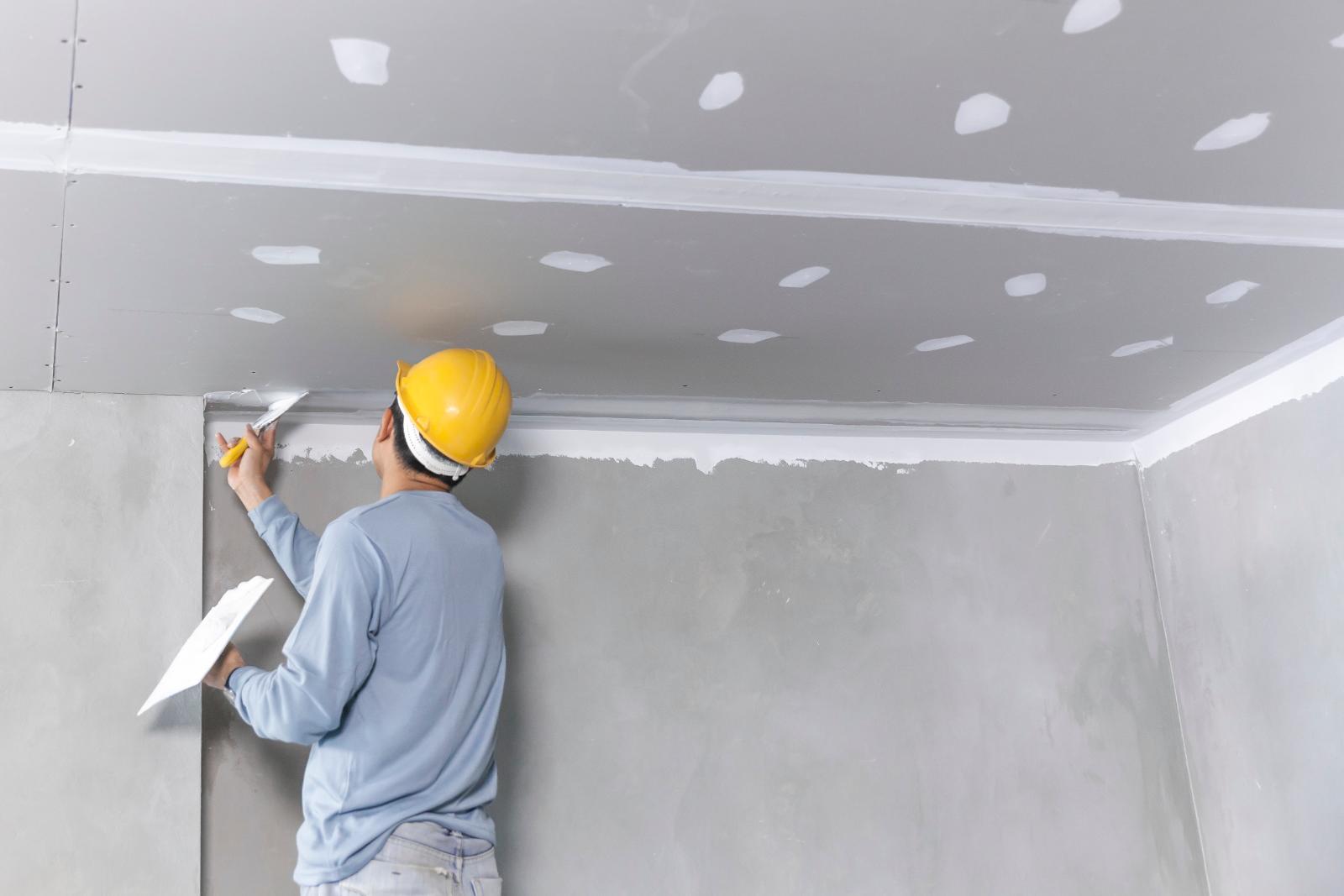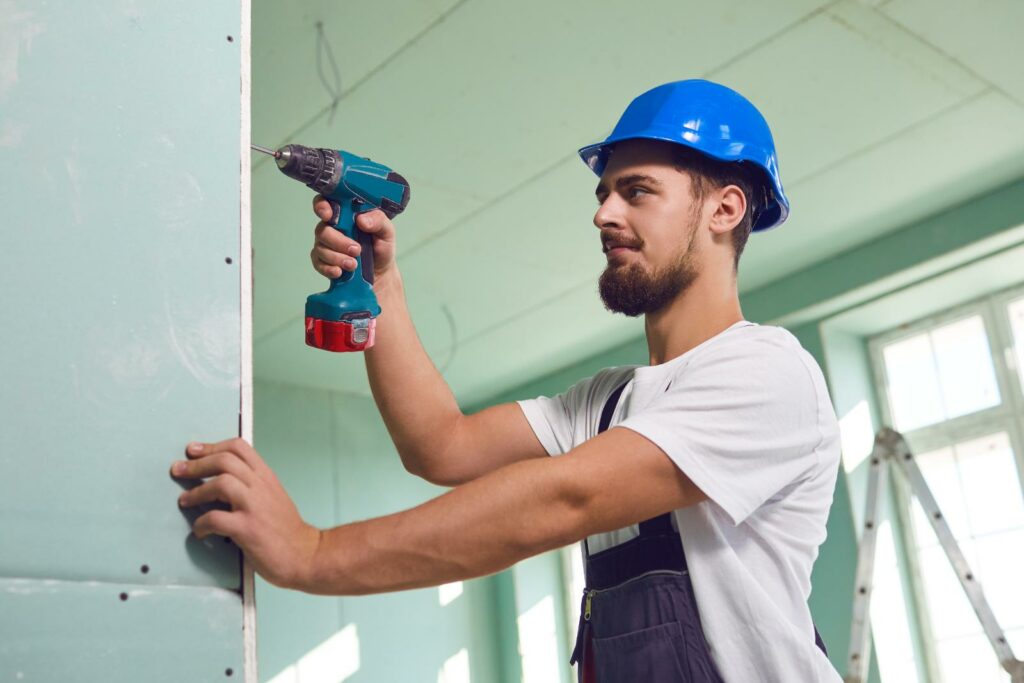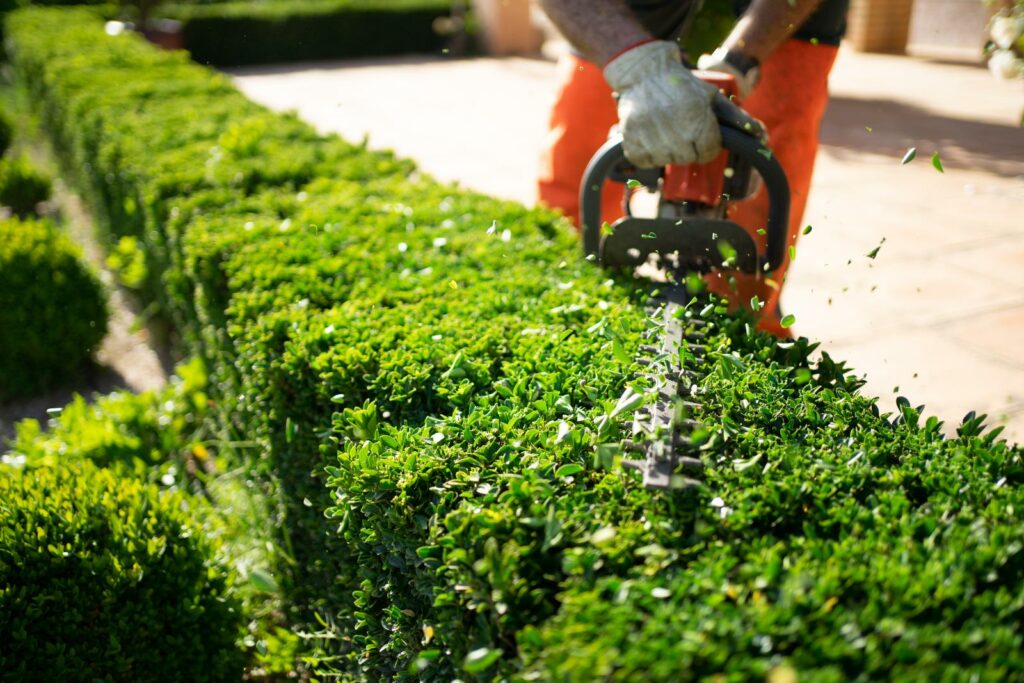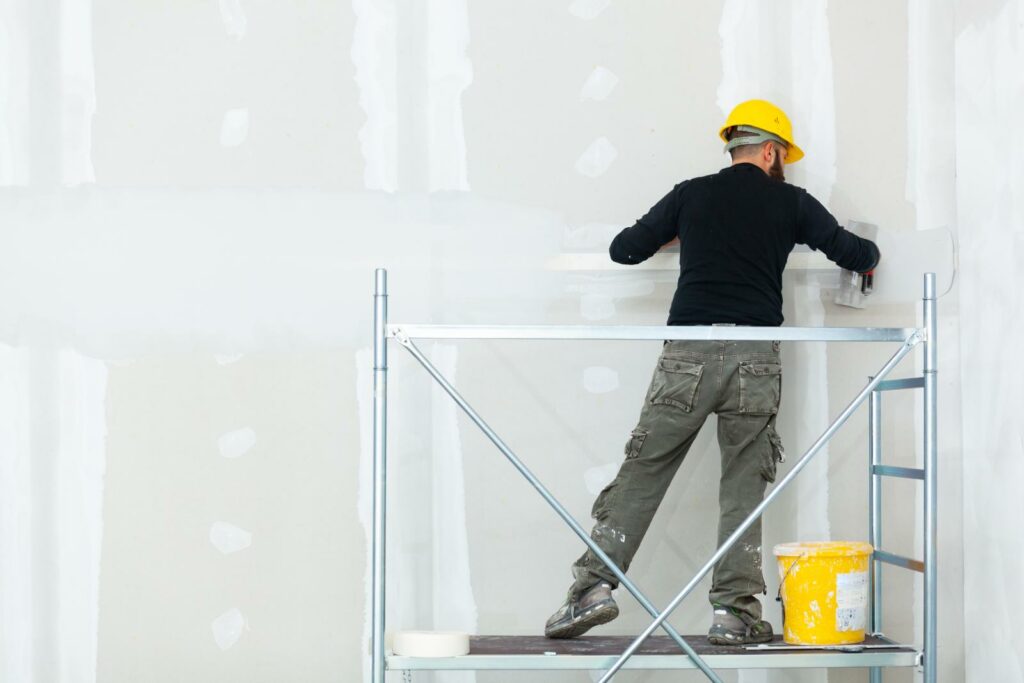Contents
If you ever find yourself staring at a fist-sized hole in your drywall, fret not; patching it up can be easier than you think. Imagine flawlessly repairing that unsightly blemish on your wall with just a few tools and some know-how. Following a straightforward DIY guide, you can tackle this task like a pro and restore your wall to its former glory. Discover the step-by-step process that will make you feel accomplished, and your walls look flawless.
Key Takeaways
- Assess damage size and type before starting repairs.
- Measure and cut drywall patch accurately for hole coverage.
- Apply spackling compound and joint compound for seamless finish.
- Sand, prime, and paint patched area for a uniform look.
- Ensure proper drying time between each step for best results.
Tools Required
To successfully patch drywall holes, gather the following tools: a putty knife, sandpaper, spackling compound, a drywall patch, a utility knife, and a paintbrush. These tools are essential for effective patching techniques and troubleshooting common issues that may arise during the process.
If you’re looking for cost-saving options or tool alternatives, consider using a butter knife or a credit card in place of a putty knife for smaller holes. Sandpaper can be substituted with a damp sponge for light sanding tasks, and DIY enthusiasts often find that a homemade spackling compound made from baking soda and glue can work effectively.
A piece of scrap drywall can be used as a patch instead of purchasing a drywall patch kit in a pinch. When cutting the patch or the damaged area, a box cutter or a multi-tool can be used instead of a utility knife. For applying paint, if a paintbrush isn’t available, a foam brush or even a clean rag can be used as alternatives.
Assessing the Damage
Evaluating the damage in your drywall is the initial step in determining the extent of repair required. Before diving into repair techniques, it’s important to identify the types of damage present. Common types include small holes from screws or nails, medium-sized holes from accidental impacts, or larger holes caused by heavy objects or plumbing mishaps. These variations in damage will impact the repair costs, with larger holes potentially requiring more materials and time.
To assess the damage accurately, start by inspecting the affected area closely. Look for any cracks, holes, or areas where the drywall seems compromised. Gently press on the damaged section to check for any softness or give, indicating underlying issues. It’s vital to avoid common mistakes such as underestimating the damage or rushing through the evaluation process, as this can lead to incomplete repairs and future issues.
Once you understand the damage, you can start planning the repair process. Consider the materials needed, such as spackle, joint compound, sandpaper, and a putty knife. By accurately evaluating the damage upfront, you can ensure a successful repair while minimizing unexpected costs or complications down the line.
Preparing the Area
Inspect the surrounding area for any debris or loose drywall pieces that need to be removed before beginning the patching process. Once you have cleared the area, follow these steps to guarantee a smooth patch:
Sanding Technique:
Use fine-grit sandpaper to gently sand the edges around the hole. This will create a smooth surface for the spackling to adhere to and blend harmoniously with the rest of the wall.Spackling Tips:
Apply a small amount of spackling compound to the hole using a putty knife. Smooth it out evenly, ensuring it’s slightly raised above the surface of the wall to account for shrinkage as it dries. Allow it to dry completely before moving on to the next step.Paint Color and Wall Texture:
Once the spackling is dry, lightly sand it again to create a flush finish with the wall. Depending on the wall texture, you may need to match it using techniques like stippling, swirling, or using a texture spray. After blending in the texture, choose the appropriate paint color to touch up the patched area. Make sure to feather the paint outwards from the center of the patch for a cohesive look that matches the rest of the wall.
Cutting the Patch
To begin cutting the patch for your drywall hole, measure and mark the area that needs to be replaced. Use a utility knife to carefully cut along the marked lines to create a patch that fits perfectly.
Remember to smooth out the edges of the patch to guarantee a smooth finish once it’s applied.
Measure and Mark
Begin by carefully measuring and marking the dimensions of the hole on the replacement drywall patch. This step is essential to ensure a precise fit and smooth repair.
Follow these steps for accurate patch placement and proper measuring:
Patch Placement: Place the replacement drywall patch over the hole, ensuring it covers the entire damaged area. Align the patch so that it matches the surrounding wall surface, allowing for a flawless finish after the repair.
Proper Measuring: Use a tape measure to determine the width and height of the hole on the wall. Transfer these measurements accurately onto the replacement drywall patch to guide your cutting process effectively.
Surface Marking: Mark the dimensions of the hole on the replacement drywall patch using a pencil or a scoring tool. Double-check the markings to confirm they match the measurements taken from the wall, ensuring a perfect fit for the patch.
Taking the time to measure and mark the replacement drywall patch accurately will set the foundation for a successful repair job.
Cut the Patch
After accurately marking the dimensions on the replacement drywall patch, proceed to cut the patch according to the outlined measurements for a precise fit. To guarantee a flawless repair, use a utility knife or drywall saw to carefully cut along the marked lines. Make sure to apply firm but controlled pressure, following the lines precisely to avoid any jagged edges. This patching technique is essential for achieving a professional finish.
When selecting the patching materials, opt for a drywall piece that matches the thickness of the existing wall. This will help maintain uniformity and make the patch blend in harmoniously. Additionally, make sure the patch is slightly larger than the hole to provide ample coverage.
Smooth Edges
Smooth the edges of the replacement drywall patch using fine-grit sandpaper to ensure a smooth transition with the surrounding wall surface. This step ensures a flawless finish once the patch is in place.
Follow these steps to achieve professional-looking results:
Sanding Technique: Hold the sandpaper firmly and use smooth, even strokes along the edges of the patch. Be gentle to avoid removing too much of the patching material, but ensure that the edges are smooth to the touch.
Edge Smoothing: Pay close attention to the corners and edges of the patch, as these areas tend to be more visible once painted. By smoothing these areas carefully, you’ll create a blend between the patch and the existing wall, making the repair nearly invisible.
Blending Paint: After sanding, wipe away any dust and prime the patched area before painting. Use the same paint color as the surrounding wall and feather the edges to blend the patch seamlessly with the rest of the wall for flawless finishing touches.
Applying the Patch
To properly apply the patch to the drywall hole, make sure that the patch is slightly larger than the hole itself for a secure fit. This guarantees that the patch covers the hole completely and has enough surface area for the joint compound to adhere to. Here’s a step-by-step guide to help you apply the patch effectively:
Step-by-Step Guide to Applying the Patch:
| Step | Instructions | Tools Needed |
|---|---|---|
| 1. Prepare the Patch | Cut a patch from a drywall piece or use a self-adhesive mesh patch. Trim it to be slightly larger than the hole. | Drywall patch, utility knife |
| 2. Apply Joint Compound | Spread a thin layer of joint compound around the edges of the hole. Press the patch firmly into place. | Joint compound, putty knife |
| 3. Smooth Out | Use a putty knife to apply more joint compound over the patch. Feather the edges to blend with the wall. | Putty knife, sandpaper |
| 4. Let it Dry | Allow the patch to dry completely before sanding it down for a smooth finish. | Patience, sanding block |
Sanding and Finishing
For a polished final result, make sure the patch is fully dried before beginning the sanding process. Once the patch is dry, follow these steps to sand and finish your drywall repair:
- Sanding Techniques
- Use a fine-grit sandpaper to smooth out the patched area. Start with a light touch and gradually increase pressure as needed.
- Feather the edges of the patch by gently blending them into the surrounding wall. This will help create a smooth finish.
- Wipe down the sanded area with a damp cloth to remove any dust or debris before moving on to the next step.
- Finishing Touches
- Prepare the wall for painting by ensuring it’s clean and free of any remaining dust. A smooth surface will result in a more professional-looking paint job.
- Apply a final coat of joint compound if necessary to fill in any small imperfections or uneven areas. Sand lightly after this step to ensure a smooth surface for painting.
- Inspect the patched area to ensure it blends seamlessly with the rest of the wall before proceeding to paint preparation.
Priming and Painting
Ready to give your patched drywall a flawless finish? The next step in your DIY project is priming and painting.
When it comes to color selection, opt for a paint that matches the existing wall color for a smooth integration. Consider the paint type as well – for drywall repairs, a quality latex paint is often recommended for its durability and ease of use.
Before painting, ensure your patched drywall is completely dry from the previous steps. Allow ample drying time to prevent any unwanted smudges or imperfections.
When you’re ready to start painting, here are a few technique tips to keep in mind: use a high-quality brush or roller for smooth application, apply paint in thin, even coats to avoid drips, and feather the edges to blend with the surrounding wall seamlessly.
Once you’ve completed painting, allow sufficient drying time as per the paint manufacturer’s instructions before applying a second coat if needed. Remember, patience is key to achieving a professional-looking finish.
With the right color selection, paint type, technique tips, and proper drying time, your patched drywall will smoothly blend in with the rest of your wall, leaving no trace of the previous hole.
Final Touches
To achieve a flawless finish, sand the patched area until it’s smooth to the touch.
After sanding, remember to prime the patched section before applying paint to guarantee a smooth blend with the rest of the wall.
Sanding for Smooth Finish
Lightly sand the drywall surface with fine-grit sandpaper in a circular motion to smooth out any rough patches and achieve a flawless finish.
Here’s how to guarantee your patched area blends harmoniously with the rest of the wall:
Lightly Sand: Gently sand the patched area in a circular motion to smooth out any imperfections. Be careful not to oversand, as this can damage the surrounding paint and drywall texture.
Check for Smoothness: After sanding, run your hand over the patched area to check for smoothness. If you feel any rough spots, continue sanding until the surface is even and integrates seamlessly.
Clean the Area: Once you’ve achieved a smooth finish, use a soft brush or a damp cloth to remove any dust or debris from the sanded area. Cleaning the surface ensures a clean foundation for the next steps in the repair process.
Priming for Paint
Before proceeding with painting, it’s vital to prime the patched drywall area to secure proper adhesion and a consistent finish. When selecting a primer, opt for one specifically designed for drywall to secure the best results. Apply the primer evenly using a paint roller or brush, covering the patched area and slightly beyond to blend with the existing wall. Allow the primer to dry completely as per the manufacturer’s instructions, typically around 1-2 hours.
For color matching, consider bringing a sample of your wall color to the paint store to find the closest match for smooth blending. Once the primer is dry, you can proceed with painting. Choose high-quality paint that complements your existing wall color, and follow the instructions for application and drying time. After painting, inspect the patched area to ensure complete coverage and smooth blending with the rest of the wall.
For the finishing touches, let the paint dry completely before evaluating if additional coats are needed for full coverage. Finally, step back and admire your handiwork, enjoying a seamlessly repaired and freshly painted wall.
Review
With the right tools and techniques, you’ve successfully patched those pesky drywall holes like a pro. Your walls are now as smooth as silk and ready to impress.
So grab that paintbrush and admire your handiwork – you’ve just turned a blemish into a work of art!
Keep up the great DIY work and enjoy your newly flawless walls.




